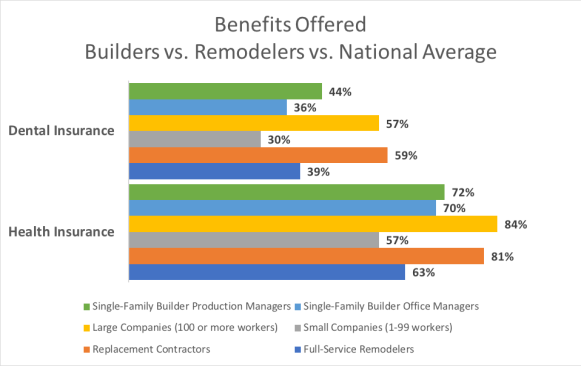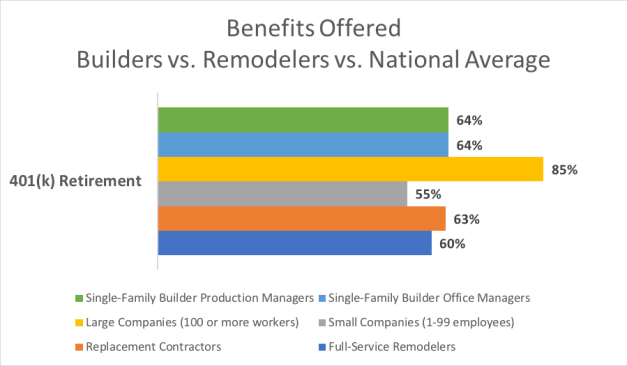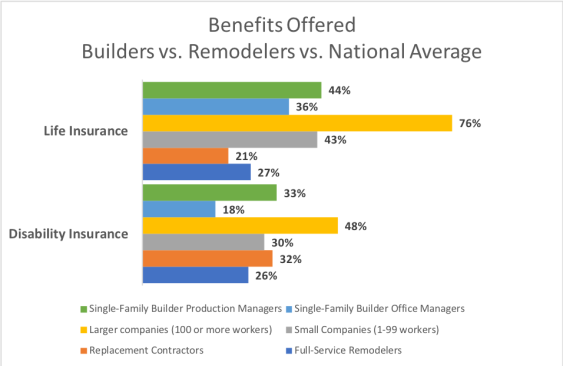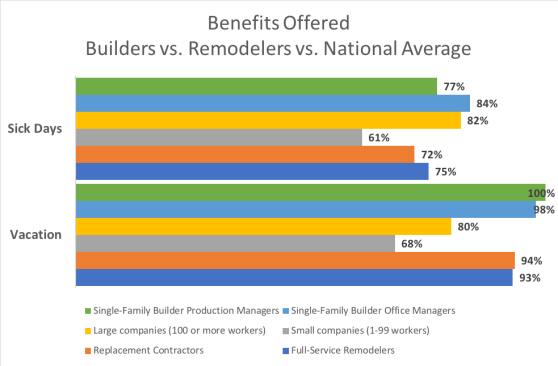If you’re like most remodelers and builders, you’re having trouble hiring new workers. One reason why could be benefits packages that don’t match what big companies offer.
Compared with companies in all industries that have at least 100 employees, remodelers and small builders are:
· Three to 21 percentage points less likely to offer health insurance;
· 13 to 18 points behind big employers on offering dental insurance;
· Up to 25 points less likely to have a 401(k) retirement plan; and
· Up to 55 points less likely to offer life insurance.
About the only area where builders and remodelers match the big guys is in paid time off.
These gaps could make the difference in luring prospects, as research suggests less than a third of workers are satisfied with their benefits package and over half of the workforce would heavily consider accepting lower-paying jobs that offered more benefits.
The gaps have ranges because we also have found differences between single-family builders, full-service remodelers, and replacement contractor/home improvement firms. For instance, single-family builders are more likely to offer employees retirement planning benefits, life insurance, and paid time off than full-service remodelers and replacement contractors.
One consolation: Benefits packages offered by single-family builders, full-service remodelers, and replacement contractors compete favorably against companies in all industries that have fewer than 100 employees. Compared with these businesses, remodelers and small builders are more likely to offer dental insurance, health insurance, 401(k) retirement plans, and paid time off.
Our Sources
These conclusions are drawn from several sources. The first is the Remodeling 550 survey, in which 335 full-service remodelers and 155 replacement contractors told us about the benefits offered to their workers. Second is the National Association of Home Builders’ Single-Family Builders Compensation Study, based on a survey of 308 single-family builders. NAHB’s report is broken down based on job types, so for our purposes took the results for office managers and production managers. Data on benefits offered by all companies was reported by the Bureau of Labor Statistics last March in its National Compensation Survey.
The builders surveyed by the NAHB have an average of 14 employees, full-service remodelers surveyed average 23 employees, and replacement contractors surveyed average 111 employees.
Health Insurance and Dental Insurance
Replacement contractors are nine to 23 percentage points more likely to offer employees dental and health insurance than full-service remodelers and single-family builders. While they’re least likely among builders and remodelers to offer health insurance, full-service remodelers are six percentage points more likely to offer health insurance than companies with fewer than 100 workers.
More than 70% of office managers, production managers, and replacement contractor employees are offered health insurance.

401(k) Retirement Planning Benefits
Builders are more likely to offer employees 401(k) retirement plans than remodelers and companies with fewer than 100 employees. Remodelers and builders are five to nine percentage points more likely to offer 401(k) benefits than the national average for similarly-sized companies.

Life Insurance and Disability Insurance
Single-family builders are more likely to offer production managers life and disability insurance than remodelers and companies with fewer than 100 employees. However, single-family builders are six to 15 percentage points less likely to offer disability insurance to office managers than remodelers. Remodelers are 17 to 22 percentage points less likely to offer life insurance than companies with fewer than 100 employees.

Paid Time Off
Single-family builders, full-service remodelers, and replacement contractors are up to 32 percentage points more likely to offer paid time off to workers than companies with fewer than 100 employees. Additionally, builders, remodelers, and replacement contractors are up to 20 percentage points more likely to offer paid vacation time than companies with 100 or more employees.

